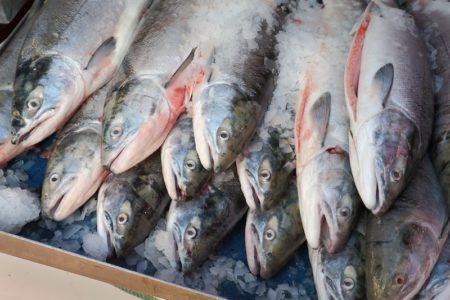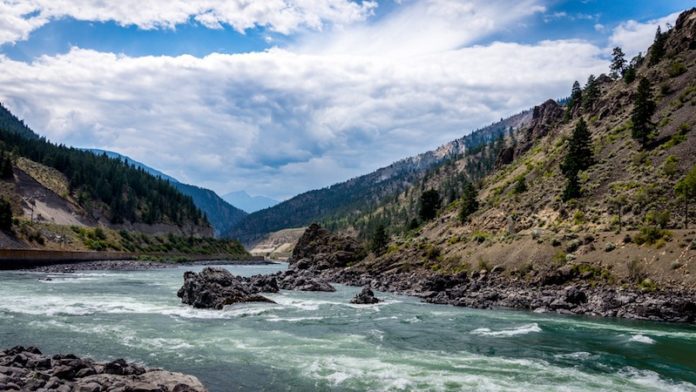Sockeye from the Fraser River comprise one of the greatest salmon stock aggregates in BC. It’s no exaggeration to describe it as a “foundation stock,” because it is so important to many diverse communities within the province. Although the phrase “Fraser sockeye” is a frequent description, it does nothing to convey the geographic distribution of these salmon within this vast watershed from the headwaters of the Driftwood River inland from the bottom end of the Alaska Panhandle to the lower reaches of the Fraser and its tributary rivers like the Pitt near Vancouver. DFO manages more than 80 individual sockeye stocks in the Fraser, made up of four main run-timing groups, mostly four years of age at maturity but with enough predominantly five-year-old stocks to keep things interesting.
After a catastrophic 1913 slide that almost blocked the river at Hell’s Gate, the stock started to rebuild in the years after World War II. For several decades the stock provided generally reliable fishing opportunities which, because of the cyclical nature of these fish, were often planned on the success of the parent generation. Of the four main cycle lines, as they are called, the one returning in 2018 has usually had the highest abundance, spectacularly so in the 2010 and 2014 returns.
As is known all too well, other than during these couple of exceptional years Fraser sockeye have been struggling for at least the past two decades, giving rise to four inquiries (DFO in-house, Fraser, Williams, and Cohen) and no explicit explanation for the decline—plenty of potential causes, all likely working in combination, but no smoking gun. And this is the background that brings more than the usual attention to the annual question about how big the return will be this year and what the fishing opportunities might be.
Based on past performance, one might think this year will see a continuation of the cycle line productivity. But if there’s one thing we should have learned in recent decades about salmon, it is that past performance is no surefire guide to the future. The returns (catch plus escapement) of Fraser sockeye in 2010 and 2014 were about 30 million and 20 million fish respectively, yet the 2015 to 2017 returns were a tenth of those numbers, similar to the returns in the years 2007 to 2009. It seems reasonable to hope that this year’s Fraser sockeye return will be larger than in the last three but, other than a simple belief that history will repeat itself, there’s little to suggest that the 2018 return will be anything close to those seen four and eight years ago. Based on the poor returns in recent years, the 2018 forecast for Fraser sockeye is weighted towards the low end of the range of possibilities, although the modelling at the higher end gives a sense of how many sockeye might show up if conditions at sea have been more favourable than expected, closer to historic norms for this cycle line.
In the big picture, the environmental conditions impacting this returning generation of Fraser sockeye can only be described as awful for salmon, and can be summed up in one short phrase: too much heat. The parent generation battled through high river temperatures in their migration up the Fraser, leading to lower spawning success. Their offspring reared in water temperatures well above normal, with unknown effects (e.g. soot and ash falling on nursery lakes) from widespread forest fires in the BC interior. The Fraser freshet was much earlier than usual in both 2015 and 2016 (outmigration years for the four- and five-year-olds returning in 2018), and when they finally made it out into the North Pacific the post-smolts found the food web there devastated by a combination of the Warm Blob and an El Niño event (2013 – 2016).
I’m not trying to be unduly pessimistic, but there’s no point in denying reality either. DFO’s forecasters have taken all this information and more into consideration and are projecting a return in the low end of the probability range (10-25%)—between 5 and 8.5 million fish. For comparison, 1964 was the last return on this cycle line of less than 5 million fish. Not so long ago the 50% probability number (a 1 in 2 chance the return will exceed it) was the standard pre-season planning tool. At 14 million fish, if the 2018 return comes anywhere close, it will be considered a good fishing season with opportunities for all.
The dominant stock in 2018 will be late summer-run Adams/Shuswap fish, accounting for about half the total Fraser sockeye return this year, followed by summer-run fish from the Chilko and Quesnel rivers, which are expected to contribute another quarter of the return. Because of this run-timing focus, it is not anticipated there will be commercial and recreational fisheries for Fraser sockeye until early August at the soonest. Harvest opportunities depend entirely on the results of the test fishing, and those hoping to catch some should stay tuned for the official fisheries notice announcement. In this year of reduced chinook opportunity, a decent fishery for Fraser sockeye would be particularly welcome, especially for anglers in the Fraser River itself.
Even though millions of dollars were spent over the past two decades on the different inquiries into the state of Fraser sockeye, it is highly regrettable that no more money seems to be allocated to doing basic research on this important salmon stock. Knowing now what we do about the critical importance to the survival of salmon of their first few months at sea, conducting systematic and focused research each year on the sockeye outmigration between the Fraser estuary and when the fish move away from the coastal environment into the open ocean would surely pay big dividends in improving forecasts for the return of these fish two years hence. Perhaps as a result of its newfound advocacy for wild salmon, the provincial government could fund this research. It would be money very well spent.







Getting the open net-cage Atlantic salmon feedlots out of BC ocean waters immediately would be very helpful!
you might want to follow us on our quest to tame the seals and seal lions and their extreme predation on chinook smolts in the Salish Sea.
for more info contact me at [email protected].
we have a very large powerful base of all walks of live working together on this project to save the chinook and help the Orcax
cheers
Ken Pearce